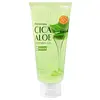What's inside
What's inside
 Key Ingredients
Key Ingredients

No key ingredients
 Benefits
Benefits

 Concerns
Concerns

 Ingredients Side-by-side
Ingredients Side-by-side

Aloe Barbadensis Leaf Juice
Skin ConditioningNelumbium Speciosum Flower Extract
Skin ConditioningCentella Asiatica Extract
CleansingBambusa Vulgaris Extract
Skin ConditioningCucumis Sativus Fruit Extract
EmollientZea Mays Leaf Extract
Skin ConditioningBrassica Oleracea Capitata Leaf Extract
Skin ConditioningCitrullus Lanatus Fruit Extract
Skin ConditioningPEG-60 Hydrogenated Castor Oil
EmulsifyingSodium Polyacrylate
AbsorbentCarbomer
Emulsion StabilisingTriethanolamine
BufferingParfum
MaskingPhenoxyethanol
PreservativeAloe Barbadensis Leaf Juice, Nelumbium Speciosum Flower Extract, Centella Asiatica Extract, Bambusa Vulgaris Extract, Cucumis Sativus Fruit Extract, Zea Mays Leaf Extract, Brassica Oleracea Capitata Leaf Extract, Citrullus Lanatus Fruit Extract, PEG-60 Hydrogenated Castor Oil, Sodium Polyacrylate, Carbomer, Triethanolamine, Parfum, Phenoxyethanol
Aloe Barbadensis Leaf Juice 95%
Skin ConditioningAlcohol Denat.
AntimicrobialWater
Skin ConditioningSaussurea Involucrata Extract
HumectantSolanum Melongena Fruit Extract
Skin ConditioningMenthyl Ethylamido Oxalate
Skin ConditioningRhodiola Rosea Root Extract
EmollientPsidium Guajava Leaf Extract
AstringentCinchona Succirubra Bark Extract
Skin ConditioningAloe Barbadensis Leaf Extract
EmollientAbronia Villosa Leaf Extract
Skin ConditioningPolyglutamic Acid
Skin ConditioningDioscorea Japonica Root Extract
Skin ConditioningDipropylene Glycol
HumectantAllantoin
Skin ConditioningGlycerin
HumectantChondrus Crispus Extract
Skin ConditioningSodium Hyaluronate
HumectantCladosiphon Okamuranus Extract
Skin ConditioningButylene Glycol
HumectantDisodium EDTA
Glyceryl Polyacrylate
C12-14 Hydroxyalkyl Maltitol Ether
EmollientEthylhexylglycerin
Skin ConditioningHydrolyzed Corn Starch
HumectantTriethanolamine
BufferingCarbomer
Emulsion StabilisingPEG-60 Hydrogenated Castor Oil
EmulsifyingBeta-Glucan
Skin Conditioning1,2-Hexanediol
Skin ConditioningSucrose
HumectantChlorphenesin
AntimicrobialPhenoxyethanol
PreservativeParfum
MaskingAloe Barbadensis Leaf Juice 95%, Alcohol Denat., Water, Saussurea Involucrata Extract, Solanum Melongena Fruit Extract, Menthyl Ethylamido Oxalate, Rhodiola Rosea Root Extract, Psidium Guajava Leaf Extract, Cinchona Succirubra Bark Extract, Aloe Barbadensis Leaf Extract, Abronia Villosa Leaf Extract, Polyglutamic Acid, Dioscorea Japonica Root Extract, Dipropylene Glycol, Allantoin, Glycerin, Chondrus Crispus Extract, Sodium Hyaluronate, Cladosiphon Okamuranus Extract, Butylene Glycol, Disodium EDTA, Glyceryl Polyacrylate, C12-14 Hydroxyalkyl Maltitol Ether, Ethylhexylglycerin, Hydrolyzed Corn Starch, Triethanolamine, Carbomer, PEG-60 Hydrogenated Castor Oil, Beta-Glucan, 1,2-Hexanediol, Sucrose, Chlorphenesin, Phenoxyethanol, Parfum
 Reviews
Reviews

Alternatives
Ingredients Explained
These ingredients are found in both products.
Ingredients higher up in an ingredient list are typically present in a larger amount.
Aloe Barbadensis Leaf Juice comes from leaves of the aloe plant. Aloe Barbadensis Leaf Juice is best known for helping to soothe sunburns. It is also anti-inflammatory, moisturizing, antiseptic, and can help heal wounds.
Aloe is packed with good stuff including Vitamins A, C, and E. These vitamins are antioxidants, which help fight free-radicals and the damage they may cause. Free-radicals are molecules that may damage your skin cells, such as pollution.
Aloe Barbadensis Leaf Juice also contains sugars. These sugars come in the form of monosaccharides and polysaccharides, folic acid, and choline. These sugars are able to help bind moisture to skin.
It also contains minerals such as calcium, 12 anthraquinones, fatty acids, amino acids, and Vitamin B12.
Learn more about Aloe Barbadensis Leaf JuiceCarbomer is a polymer of acrylic acid. Its main role is to create a gel consistency.
A high amount of carbomer can cause pilling or balling up of products. Don't worry, most products contain 1% or less of carbomer.
Parfum is a catch-all term for an ingredient or more that is used to give a scent to products.
Also called "fragrance", this ingredient can be a blend of hundreds of chemicals or plant oils. This means every product with "fragrance" or "parfum" in the ingredients list is a different mixture.
For instance, Habanolide is a proprietary trade name for a specific aroma chemical. When used as a fragrance ingredient in cosmetics, most aroma chemicals fall under the broad labeling category of “FRAGRANCE” or “PARFUM” according to EU and US regulations.
The term 'parfum' or 'fragrance' is not regulated in many countries. In many cases, it is up to the brand to define this term.
For instance, many brands choose to label themselves as "fragrance-free" because they are not using synthetic fragrances. However, their products may still contain ingredients such as essential oils that are considered a fragrance by INCI standards.
One example is Calendula flower extract. Calendula is an essential oil that still imparts a scent or 'fragrance'.
Depending on the blend, the ingredients in the mixture can cause allergies and sensitivities on the skin. Some ingredients that are known EU allergens include linalool and citronellol.
Parfum can also be used to mask or cover an unpleasant scent.
The bottom line is: not all fragrances/parfum/ingredients are created equally. If you are worried about fragrances, we recommend taking a closer look at an ingredient. And of course, we always recommend speaking with a professional.
Learn more about ParfumPeg-60 Hydrogenated Castor Oil comes from hydrogenated castor oil. It is a solubilizer and emulsifier.
As a solubilizer, it helps dissolve ingredients into a water-based version. It is also an emulsifer. Emulsifier help prevent oils and water from separating. Both these properties help create evenly-spread and uniform products.
Basically, Peg-60 Hydrogenated Castor Oil helps hold ingredients together.
Learn more about PEG-60 Hydrogenated Castor OilPhenoxyethanol is a preservative that has germicide, antimicrobial, and aromatic properties. Studies show that phenoxyethanol can prevent microbial growth. By itself, it has a scent that is similar to that of a rose.
It's often used in formulations along with Caprylyl Glycol to preserve the shelf life of products.
Triethanolamine is an emulsifier and pH adjuster. It is created using ethylene oxide and ammonia. This gives Triethanolamine a nitrogen core and a similar scent to ammonia.
As an emulsifier, it prevents ingredients from separating and enhances texture by adding volume to a product.
PH adjusters are common in cosmetic products. The pH of a product can affect the effectiveness of other ingredients. A product with a high pH may also irritate the skin.
Learn more about Triethanolamine